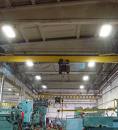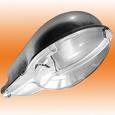Operation of lighting electrical installations
 In the case of insufficient lighting in the production halls, eyesight deteriorates and labor productivity falls, the quality of products decreases. Therefore, for industrial enterprises, the minimum lighting norms provided by SNiP and PUE.
In the case of insufficient lighting in the production halls, eyesight deteriorates and labor productivity falls, the quality of products decreases. Therefore, for industrial enterprises, the minimum lighting norms provided by SNiP and PUE.
The illuminance values according to these standards depend on the nature of the production, and the higher, the greater accuracy is required when performing technological processes and production operations. In the lighting design and calculations, it is assumed that the illuminance is slightly higher than required by the standards.
This margin is due to the fact that during operation the initial (project) lighting level inevitably decreases over time. This is due to a gradual decrease in the luminous flux of the lighting fixtures, pollution of the fittings and some other reasons. The illuminance reserve taken in the design and calculations is sufficient for the normal operation of electrical lighting installations: regular cleaning of lamps, light guides, timely replacement of lamps, etc.In the event of unsatisfactory performance, the assumed illuminance reserve cannot compensate for the decreasing illuminance level and becomes insufficient.
It should be borne in mind that the lighting of the room is strongly influenced by the color of the walls and ceilings and their condition... Painting in light colors and regular cleaning from pollution help to ensure the necessary standards of illumination. The frequency of inspections of lighting electrical installations depends on the nature of the premises, the state of the environment and is established by the chief energy engineer of the enterprise. Previously, for dusty rooms with an aggressive environment, the required frequency of work lighting checks can be done once every two months, and in rooms with a normal environment — once every four months. For emergency lighting installations, the inspection time is reduced by 2 times.
Inspections of lighting installations
When inspecting lighting electrical installations, they check the condition of electrical wires, shields, lighting devices, automata, switches, sockets and other elements of the installation. They also check the reliability of the contacts in the installation: loose contacts should be tightened, and burnt ones should be cleaned or replaced with new ones.
Changing lamps in lighting fixtures
In production workshops of industrial enterprises There are two ways to change lamps: individual and group. In the individual method, lamps are replaced when they fail; in the group method they are replaced in groups (after they have served the prescribed number of hours).The second method is economically more advantageous, as it can be combined with cleaning the lighting fixtures, but it is associated with a large consumption of lamps.
When replacing, do not use lamps with a higher power than is allowed for the light fixture. The overestimated power of the lamp leads to unacceptable overheating of the lamps and sockets and deteriorates the condition of the insulation of the wires.
Lighting fixtures and fixtures are cleaned of dust and soot in workshops with low pollutant emissions (mechanical and tool workshops, machine rooms, leather for water, etc.) twice a month; with high emission of pollutants (forges and foundries, spinning mills, cement plants, mills, etc.) four times a month. They clean all elements of lighting fixtures — reflectors, diffusers, lamps and external surfaces of the armature. Cleaning windows for natural light is done as soon as they get dirty.
Working and emergency lighting in production shops, they are switched on and off according to a schedule only when natural light is not sufficient for the production of work.
Inspection and testing of lighting installations during operation
Electric lighting installations are subjected to a number of checks and tests during operation. The insulation resistance of the working and emergency lighting is checked. The operation of the emergency lighting system is checked by turning off the working lights at least once a quarter. The automatic light switch or emergency switch is checked once a week during the day.For stationary transformers for voltage 12 — 36 V, the insulation is tested once a year, and for portable transformers and lamps for 12 — 36 V — every three months.
Photometric measurements of indoor lighting
 Photometric measurements of illuminance in the main production and technological workshops and premises with control of the compliance of the lamp power with the project and calculations are carried out once a year. Lighting is checked using a light meter in all production workshops and main workplaces. The obtained illuminance values must — correspond to the calculated and design values.
Photometric measurements of illuminance in the main production and technological workshops and premises with control of the compliance of the lamp power with the project and calculations are carried out once a year. Lighting is checked using a light meter in all production workshops and main workplaces. The obtained illuminance values must — correspond to the calculated and design values.
Before starting to check the illuminance, it is necessary to establish the places where it is advisable to measure the illuminance. The results of inspections and inspections are drawn up with acts approved by the chief energy engineer of the enterprise. Characteristics of operation of gas discharge light sources
Performance characteristics of fluorescent lamps and high pressure gas discharge lamps
The industry produces the following gas-discharge light sources with lamps:
- luminescent mercury low pressure;
- high pressure mercury arc (DRL type);
- xenon (type DKst) with air cooling and high pressure water cooling;
- high and low pressure sodium lamps.
The first two types of lamps are the most common.
 Discharge lamps have the following main characteristics. The light efficiency (efficiency) of incandescent lamps is in the range of 1.6-3%, and their light efficiency does not exceed 20 lm / W power consumption for high-power lamps and decreases to 7 lm / W for lamps with power up to 60 WThe luminous efficiency of fluorescent lamps and DRL lamps reaches 7%, and the luminous efficiency exceeds 40 lm / W. However, such lamps are included in the electrical network only through ballasts (ballasts).
Discharge lamps have the following main characteristics. The light efficiency (efficiency) of incandescent lamps is in the range of 1.6-3%, and their light efficiency does not exceed 20 lm / W power consumption for high-power lamps and decreases to 7 lm / W for lamps with power up to 60 WThe luminous efficiency of fluorescent lamps and DRL lamps reaches 7%, and the luminous efficiency exceeds 40 lm / W. However, such lamps are included in the electrical network only through ballasts (ballasts).
Lighting a fluorescent lamp and especially a DRL lamp takes some time. (from 5s to 3 — 10 minutes). The main element of the ballast is usually an inductive resistance (reactor) that degrades Power factor; therefore apply capacitorsbuilt into modern ballasts.
The industry produces general purpose fluorescent lamps with power from 4 to 200 watts. Lamps with power from 15 to 80 W are serially produced in accordance with GOST. The rest of the lamps are produced in small batches according to the relevant specifications. One of the characteristics of the operation of fluorescent lighting is the difficulty of detecting a malfunction compared to the use of incandescent lamps. This is due to the fact that the most common scheme for turning on fluorescent lamps contains starter and gas (ballast resistance) and becomes much more complicated than the circuit for switching an incandescent lamp.
Another feature of fluorescent lighting is that for normal lighting and operation of the fluorescent lamp, the mains voltage should not be less than 95% of the nominal. Therefore, when working with fluorescent lamps, it is necessary to monitor the voltage in the network. The normal operating mode of the fluorescent lamp is ensured at a temperature of 18-25 ° C; at a lower temperature, the fluorescent lamp may not light up.
During operation, the inspection of fluorescent lamps is carried out more often than incandescent lamps... The inspection of fluorescent lamps is recommended to be carried out daily, and the dust cleaning and operation check - at least once a month.
At exploitation it is also necessary to take into account that after the end of the normal life of a fluorescent lamp (about 5 thousand hours), it practically loses its quality and must be replaced... A lamp that flashes or lights only at one end must be replaced.
